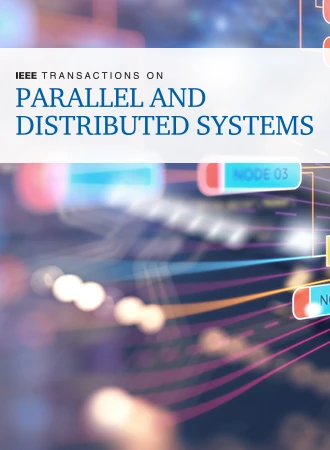边缘云中联合学习的参与者和学习拓扑选择
IF 5.6
2区 计算机科学
Q1 COMPUTER SCIENCE, THEORY & METHODS
IEEE Transactions on Parallel and Distributed Systems
Pub Date : 2024-06-13
DOI:10.1109/TPDS.2024.3413751
引用次数: 0
摘要
在边缘云中部署联合学习(FL)是一项挑战,尤其是在资源有限的边缘环境中同时训练多个模型时。关于联合边缘学习的现有研究主要集中在训练单一 FL 模型的客户端选择上,通常采用固定的学习拓扑结构。初步实验表明,具有可适应拓扑结构的 FL 模型与具有固定拓扑结构的模型相比,学习成本更低。本文深入探讨了为同时在边缘云中训练的多个 FL 模型联合选择参与者和学习拓扑的复杂性。该问题被表述为一个整数非线性编程问题,旨在最小化与所有 FL 模型相关的总学习成本,同时遵守边缘资源约束。为解决这一具有挑战性的优化问题,我们引入了一种两阶段算法,将原始问题分解为两个子问题,并采用高效启发式迭代法分别解决它们。我们的方法允许 FL 模型独立选择参与者和学习拓扑,从而增强了边缘云中的资源竞争和负载平衡。利用真实世界网络和 FL 数据集进行的大量实验证实了我们的算法具有更好的性能,与之前为多模型 FL 设计的方法相比,平均总成本分别降低了 33.5% 和 39.6%。本文章由计算机程序翻译,如有差异,请以英文原文为准。
Joint Participant and Learning Topology Selection for Federated Learning in Edge Clouds
Deploying federated learning (FL) in edge clouds poses challenges, especially when multiple models are concurrently trained in resource-constrained edge environments. Existing research on federated edge learning has predominantly focused on client selection for training a single FL model, typically with a fixed learning topology. Preliminary experiments indicate that FL models with adaptable topologies exhibit lower learning costs compared to those with fixed topologies. This paper delves into the intricacies of jointly selecting participants and learning topologies for multiple FL models simultaneously trained in the edge cloud. The problem is formulated as an integer non-linear programming problem, aiming to minimize total learning costs associated with all FL models while adhering to edge resource constraints. To tackle this challenging optimization problem, we introduce a two-stage algorithm that decouples the original problem into two sub-problems and iteratively addresses them separately with efficient heuristics. Our method enhances resource competition and load balancing in edge clouds by allowing FL models to choose participants and learning topologies independently. Extensive experiments conducted with real-world networks and FL datasets affirm the better performance of our algorithm, demonstrating lower average total costs with up to 33.5% and 39.6% compared to previous methods designed for multi-model FL.
求助全文
通过发布文献求助,成功后即可免费获取论文全文。
去求助
来源期刊

IEEE Transactions on Parallel and Distributed Systems
工程技术-工程:电子与电气
CiteScore
11.00
自引率
9.40%
发文量
281
审稿时长
5.6 months
期刊介绍:
IEEE Transactions on Parallel and Distributed Systems (TPDS) is published monthly. It publishes a range of papers, comments on previously published papers, and survey articles that deal with the parallel and distributed systems research areas of current importance to our readers. Particular areas of interest include, but are not limited to:
a) Parallel and distributed algorithms, focusing on topics such as: models of computation; numerical, combinatorial, and data-intensive parallel algorithms, scalability of algorithms and data structures for parallel and distributed systems, communication and synchronization protocols, network algorithms, scheduling, and load balancing.
b) Applications of parallel and distributed computing, including computational and data-enabled science and engineering, big data applications, parallel crowd sourcing, large-scale social network analysis, management of big data, cloud and grid computing, scientific and biomedical applications, mobile computing, and cyber-physical systems.
c) Parallel and distributed architectures, including architectures for instruction-level and thread-level parallelism; design, analysis, implementation, fault resilience and performance measurements of multiple-processor systems; multicore processors, heterogeneous many-core systems; petascale and exascale systems designs; novel big data architectures; special purpose architectures, including graphics processors, signal processors, network processors, media accelerators, and other special purpose processors and accelerators; impact of technology on architecture; network and interconnect architectures; parallel I/O and storage systems; architecture of the memory hierarchy; power-efficient and green computing architectures; dependable architectures; and performance modeling and evaluation.
d) Parallel and distributed software, including parallel and multicore programming languages and compilers, runtime systems, operating systems, Internet computing and web services, resource management including green computing, middleware for grids, clouds, and data centers, libraries, performance modeling and evaluation, parallel programming paradigms, and programming environments and tools.
 求助内容:
求助内容: 应助结果提醒方式:
应助结果提醒方式:


